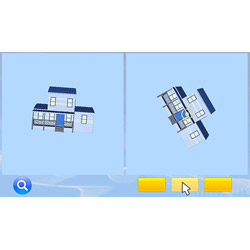
Spatial Processing: Mental Rotation (ROTATE) Module
Model 65324
ROTATE trains the ability to form a three-dimensional mental image of an object depicted in two dimensions and to manipulate the image by means of a change of perspective or rotation (mental rotation).
Setting and Task
In the ROTATE training program the client is shown 3D objects that he must compare with reference pictures. Two types of task are presented alternately.
- In the change of perspective tasks the client sees the object on the right-hand side of the screen surrounded by cameras. He must work out which camera was used to take the picture shown on the left of the screen.
- The rotation tasks are similar. In this case the screen shows symbolic axes of rotation ("rotation rods"), which can be used to rotate the object in space. The client must work out which axis needs to be used to rotate the object in order to create the reference picture.
Theory
Current theoretical models of this ability area assume that the process of solving mental rotation problems involves four stages (see Just & Carpenter 1985, Arendasy & Sommer 2010):
- Search stage: the search for corresponding object parts
- Encoding stage: constructing a mental image of the object to be rotated
- Transformation stage: transformation by means of rotation or change of perspective
- Confirmation stage: comparison of actual results with intended outcome
Studies show that this ability can be improved through training and practice. In general the best results are achieved by using training methods in which different spatial strategies are permitted and practiced (for a summary: Handet al., 2007).
Difficulty Structure
Difficulty is varied across the various levels mainly by changing the following task characteristics:
- figural complexity of the objects
- direction and angle of rotation
- object's positional complexity
- complexity of the coordinate system implied by the cameras or rotation rods
The training program uses objects of various different types (e.g. cartoons, buildings). The aim of using a wide range of practice material is to improve the client’s motivation to train and to ensure that the cognitive skill that is developed can be generalized effectively.
